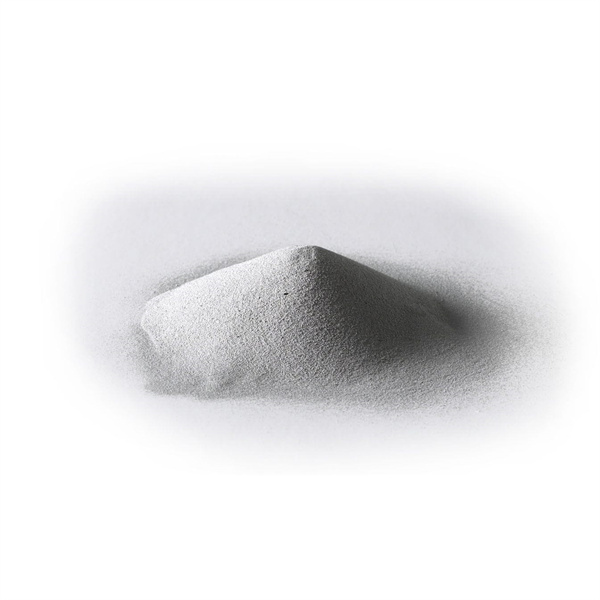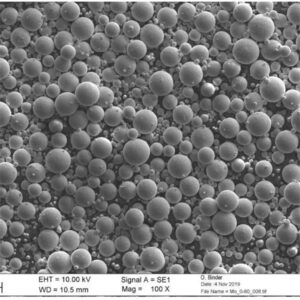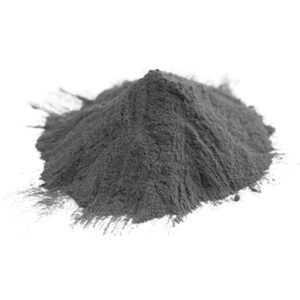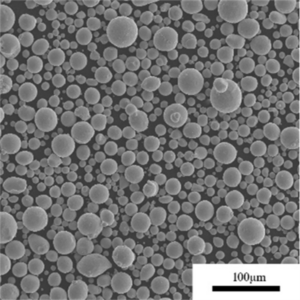概述
钛粉是一种多功能金属材料,具有高强度、低密度、耐腐蚀和生物相容性的独特组合。作为一种粉末,钛有利于采用先进的制造技术,如金属注射成型(MIM)、增材制造(AM)、热等静压(HIP)和粉末冶金(PM)压制和烧结,以制造复杂的钛部件。
钛粉的主要应用领域包括航空航天部件、医疗植入物、汽车部件、运动器材、化学加工和消费品。本指南全面介绍了钛粉,包括生产方法、合金成分、特性、属性、规格、应用和全球供应商。旨在帮助工程师、产品设计师和技术项目经理选择和使用钛粉。 钛粉.

钛粉生产
钛粉的主要生产方法如下:
钛粉生产方法
- 气体雾化 - 高压惰性气体将熔融钛分解成球形粉末
- 等离子体雾化 - 钛电极电弧产生超细球形粉末
- 水合/脱水 - 氢化钛粉(TiO2)脱水成细粉
- 机械铣削 - 球磨将钛屑分解成不规则颗粒
- 血浆球体化 - 在等离子体中熔化的不规则粉末产生球形形状
最常见的是气体雾化和机械研磨,分别产生球形和角形粉末。此外,筛分、调节和混合还能形成特定应用的粒度分布。
钛粉的成分
虽然纯商业 钛粉 大多数工业用粉末都含有少量合金元素:
常见钛粉成分
| 合金 | 主要合金元素 | 主要特点 |
|---|---|---|
| CP 钛 | 99.5%+ Ti | 卓越的耐腐蚀性 |
| 钛-6Al-4V | 6% Al、4% V | 高强度、可热处理 |
| 钛-6Al-7Nb | 6% Al、7% Nb | 高强度、生物相容性 |
| Ti-555 | 5% Al、5% Mo、5% V | 可热处理、可机加工 |
| Ti-1023 | 10% V、2% Fe、3% Al | 强度高、延展性好 |
铝、钒和铌是常见的添加剂,可提高强度和加工性。此外还有微量的硼、碳、铁和氧。
合金可调整微观结构、硬度、机加工性能和其他性能,同时保持优异的耐腐蚀性。
钛粉的特性
钛粉的主要特点包括
钛粉特性
| 特征 | 典型值 | 重要意义 |
|---|---|---|
| 颗粒大小 | 10 - 150 微米 | 烧结性能、表面光洁度 |
| 粒子形状 | 球状、角状、树枝状 | 粉末流动和堆积密度 |
| 表观密度 | 1.5 - 4.0 克/立方厘米 | 按压和操作行为 |
| 水龙头密度 | 2.5 - 4.5 克/立方厘米 | 压缩性指标 |
| 霍尔流量 | 25 - 35 秒/50 克 | 粉末流动性 |
| 点火损失 | 0.1 - 0.5 wt% | 氧气和水分含量 |
| 发火性 | 无 | 易燃性和处理注意事项 |
粒度分布和粉末形状对粉末流动、压实、烧结反应以及压制和烧结部件的密度有很大影响。表观密度表示粉末的可压缩性。
的特性 钛粉
钛粉的主要特性包括
钛粉性能
| 物业 | 纯钛 | 钛-6Al-4V | 钛-6Al-7Nb |
|---|---|---|---|
| 密度 | 4.5 克/立方厘米 | 4.43 克/立方厘米 | 4.52 克/立方厘米 |
| 拉伸强度 | 240 兆帕 | 930 兆帕 | 900 兆帕 |
| 屈服强度 | 170 兆帕 | 860 兆帕 | 825 兆帕 |
| 伸长率 | 24% | 10% | 15% |
| 弹性模量 | 102 GPa | 114 GPa | 105 GPa |
| 硬度 | 80 HB | 334 HB | 321 HB |
| 热容量 | 522 J/kg-K | 526 J/kg-K | 527 焦耳/千克-千卡 |
| 导热性 | 7.2 W/m-K | 7.2 W/m-K | 6.7 瓦/米-千克 |
与铝、钒和铌进行合金化可显著提高强度和硬度。具体性能在很大程度上取决于最终的微观结构。
钛粉的应用
钛粉的主要应用包括
钛粉应用
| 行业 | 用途 | 主要原因 |
|---|---|---|
| 航空航天 | 结构部件、涡轮叶片、紧固件 | 高强度重量比 |
| 医疗 | 整形外科植入物、牙科植入物、手术工具 | 生物相容性、耐腐蚀性 |
| 汽车 | 连杆、阀门、弹簧、紧固件 | 重量轻、性能好 |
| 化学 | 储罐、管道、阀门、泵 | 耐腐蚀性 |
| 体育用品 | 高尔夫球杆、自行车、头盔 | 强度、量身定制的机械性能 |
| 石油化工 | 井下工具、井口部件 | 强度、耐腐蚀性 |
钛的独特性能使其在极端环境下保持机械完整性的同时,还能减轻航空航天部件的重量。
出色的生物相容性和耐腐蚀性推动了钛在整形外科和牙科植入物中的应用。对钛的特性进行定制的能力有助于生产具有特殊性能特点的体育用品。
钛粉规格
钛粉的成分和质量由各种标准规范确定:
钛粉标准
| 标准 | 范围 | 颗粒大小 | 纯净 | 化学 |
|---|---|---|---|---|
| ASTM B348 | 1-4 级非合金钛粉 | -635目 | 99.5%, 99.9%, 99.95% Ti | O、C、N、H 限制 |
| ASTM B801 | Ti-6Al-4V 合金粉末 | -635目 | 钛、铝、钒成分范围 | 间隙限制 |
| ISO 23301 | 快速成型钛粉 | 10-45 微米 | 99.5%+ Ti | O、N、C、H、Fe 限制 |
| AMS 4992 | 航空航天级 Ti-6Al-4V 粉末 | -150目 | 钛、铝、钒成分范围 | 间隙限制 |
这些标准规定了合金添加量、氧/氮/碳等杂质的可接受水平、粒度分布以及与不同应用相关的其他测试方法。
全球供应商 钛粉
许多大公司和较小的地区制造商都生产钛粉:
钛粉制造商
| 供应商 | 生产方法 | 材料 | 能力 |
|---|---|---|---|
| ATI 金属公司 | 气体雾化 | Ti-6Al-4V、Ti-1023、纯钛 | 合金范围广,体积大 |
| 普莱克斯 | 气体雾化 | Ti-6Al-4V, CP Ti | 批量小,交货快 |
| 木匠添加剂 | 气体雾化,氢化物-氢化物 | Ti-6Al-4V、Ti-6Al-7Nb、纯钛 | 定制合金,小批量 |
| AP&C | 等离子雾化 | CP Ti、Ti 合金 | 10-45 微米超细粉末 |
| 泰克纳 | 血浆球体化 | Ti-6Al-4V, CP Ti | 将芯片转化为球形粉末 |
| 宝鸡汉斯钛业有限公司 | 水力 | CP Ti、Ti-6Al-4V | 低成本中国生产商 |
许多公司既提供标准合金成分,也提供定制合金成分。有些还提供将废料和切屑加工成粉末的收费加工服务。
选择钛粉
选择钛粉的主要考虑因素包括
- 合金成分 - 平衡所需的特性,如强度、延展性和硬度
- 纯度 - 影响机械性能和微观结构
- 颗粒大小和形状 - 影响粉末流动、密度和表面光洁度
- 表观密度和敲击密度 - 表示可压缩性和烧结反应
- 化学兼容性 - 适用于酸或盐水等使用条件
- 取样程序 - 粉末批次的代表性测试
- 质量认证 - ISO 9001、AS9100 等。
- 技术专长 来自粉末生产商
样品和原型有助于鉴定新合金和新粉末在特定应用中的性能。与信誉良好的供应商密切合作,获得特性良好的钛粉,以获得最佳效果。

常见问题
等离子雾化钛粉有什么好处?
等离子雾化可产生非常球形的流动颗粒,大小通常为 10-45 微米。这使得烧结密度和表面光洁度极佳。
钛粉发火的原因是什么?
发火钛粉在空气中会自燃。这是由于 10 微米以下的颗粒尺寸极小,大大增加了表面积和反应活性。使用惰性气体处理发火粉末。
颗粒形状如何影响钛粉性能?
球形粉末流动性好,密度和机械性能更高且更均匀。不规则粉末具有更好的生坯强度和可压缩性,但收缩预测性较差。
哪些后处理方法可以提高钛粉的重复利用率?
通过筛分、研磨和热处理,可以重新利用不符合规格的粉末。等离子球化技术可将碎屑和较粗颗粒转化为球形粉末原料。
哪些标准适用于钛合金零件的增材制造?
ASTM F3001-14 涵盖 AM 用钛合金粉末的表征和质量控制。ASTM F2924-14 提供了评估 AM 钛机械性能的标准测试方法。
您能 3D 打印出钛钢复合结构吗?
是的,某些金属三维打印工艺通过精确的材料切换,在一个部件内实现钛合金和不锈钢合金之间的转换,从而制造出双金属部件。
结论
钛粉凭借其独特的金属特性,为工程师制造高性能部件提供了极大的灵活性。精心选择粉末特性并与经验丰富的供应商密切合作,可在许多关键应用中实现最佳效果。钛粉末冶金工艺的能力、质量和成本效益不断提高。



